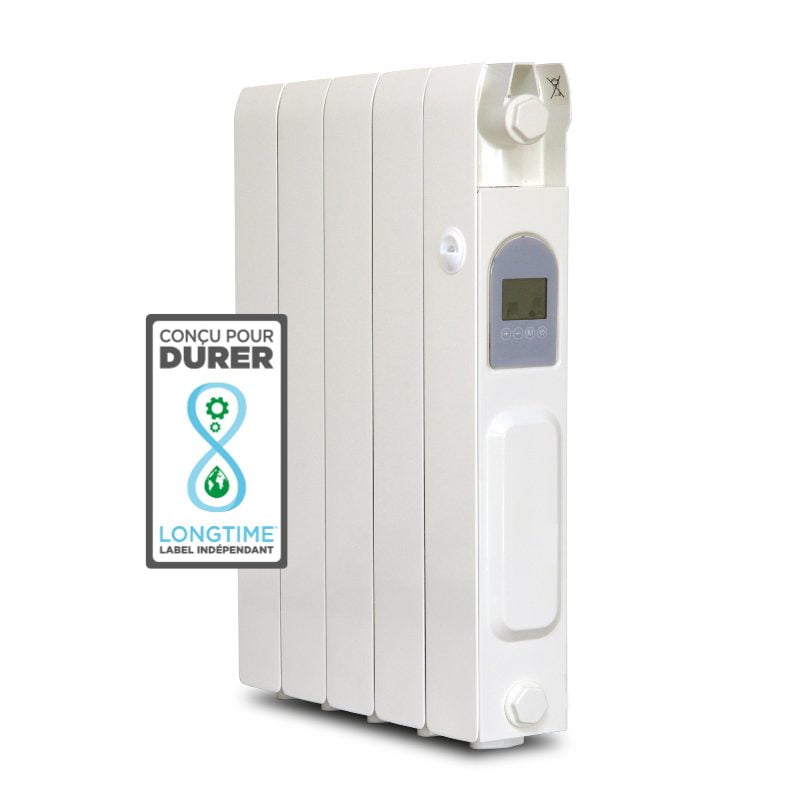How to choose a sustainable electric radiator
A reliable, robust and repairable electric heater?
Find out about LONGTIME® eco-friendly electric radiators.
Want to know everything there is to know about choosing a reliable electric radiator?
Read our guide to buying sustainable electric radiators, based on feedback from our quality experts.
Whether you're renting an apartment with a toaster, a young couple just starting out or a homeowner for 30 years, heating your home well and spending as little money as possible is essential.
So you've decided to replace your old electric radiators with newer ones. Even if it means investing a little money vous souhaitez acquérir un radiateur durable, c’est-à-dire fiable et réparable.

If the rest of this article seems a little complex, simply put your trust in the LONGTIME® label. An electric dry inertia radiator recently received the label after being independently assessed against our 41 sustainability criteria. And what's more, it's 100% French.
Why choose a dry inertia electric radiator?
These electric radiators are very interesting because they deliver gentle, even and homogeneous heat, giving you the feeling of central heating.
The operating principle is simple: a heating element heats up to allow the radiator's heating core to store thermal energy (calories). When the radiator and the resistor are switched off, the heating core radiates and continues to release the stored heat. To illustrate this, let's go back to childhood and campfires. During campfires, we notice that the stones surrounding the fire heat up and stay hot long after the fire has been extinguished. They have accumulated energy and the inertia of the stone means that the heat is released slowly but over a long period. Dry or liquid inertia radiators and storage heaters work on this principle.
Anatomy of the electric radiator
Electric radiators all have roughly the same anatomy:
- The heating element, also known as the heating box, is the visible external part.
- The heating core, located in the heating body, is the internal part that stores the heat.
- The resistor, associated with the heating core, is responsible for heating up the radiator by circulating electric current.
- The thermostatic control, or thermostat, is the radiator's brain, consisting mainly of a temperature sensor, an electronic card for controlling the radiator and a display module for interacting with the radiator.
For each of the above elements, a wide range of industrial choices is available. The technical choices made by the manufacturer will influence the performance, lifespan and price of the radiator.
How to choose the right heating element for your electric radiator?
Be careful not to confuse core and heating element.
The radiator body is the external element of the radiator. It is the surface that allows heat exchange between the heating core and your home. The faster the heating element rises to temperature and diffuses heat, the better your product will be. The material of choice in this case is aluminium. You need to be sure of the quality of the aluminium.
Heater boxes can be made up of a single block, two parts or several separate components. Obviously, it's better to be able to replace just one part in the event of damage than the whole unit.Paint is a factor not to be neglected. It must resist yellowing, micro-scratches and heat. Choose a radiator with a baked-on epoxy powder coating.
Finally, the icing on the cake is that some electric radiators feature a heating film on the inner surface of the heating box, allowing heat to be distributed almost immediately, while the heating core heats up.
What are the best heating cores for dry inertia electric radiators?
Be careful not to confuse core and heating element.
In dry inertia radiators, the heating core is made of a solid material (ceramic, natural stone, cast iron, aluminium) as opposed to liquid inertia, which uses a fluid. But not all core materials are created equal. The differences are in refractive power, mechanical resistance to wear (thermal stress) and weight.
Ceramics and earthenware: These materials benefit from excellent inertia coupled with durable physical characteristics. Their quality is intrinsically linked to two factors: the quality of the raw materials used in their composition (silica, etc.) and the quality of manufacture offered by the ceramist. The weight is kept under control, as is the cost, making this material an ideal choice in terms of value for money.
Natural stone, lava stone, soapstone or steatite, marble, granite: These high-density materials are all excellent heating cores, benefiting from great inertia and resistance over time. Less heavy than cast iron, weight is still a factor to be taken into account, as is price. These "noble" materials are generally found on more upmarket radiators.
Cast iron: With its excellent capacity to absorb and diffuse heat, as well as its excellent mechanical strength, cast iron has a very slow temperature rise, and its weight makes radiators heavy, unwieldy and imposing.
L’aluminium : Light and cheap, aluminium is the most commonly used material. It heats up very quickly, but stores heat very poorly and will therefore perform less well. You rarely get everything for nothing!
Electric resistance for electric radiators
The electrical resistance(s) used in electric radiators must follow two main principles in order to be of high quality:
1) Impeccable design and manufacturing quality
A good electrical resistor generally consists of a chromium-plated nickel wire, known as Nichrome (80% nickel and 20% chromium). This wire must be as insulated as possible from oxygen to prevent premature ageing or breakage. The wire can be surrounded by a high-density magnesium oxide powder, then sheathed or completely integrated into the heating core.
2) Perfectly integrated into the heater core
The integration of the resistor into the heating core has an influence on both the reliability and repairability of the radiator. The resistor can either be placed on the periphery of the heating core or completely integrated into the heating core.
- Resistor at the periphery of the heating core: This solution offers better repairability, but requires perfect insulation of the resistor, with a higher potential risk of breakage.
- Resistor integrated into the heating core: This solution offers a lower risk of failure, but more limited repairability.
Electric radiators can be multi-resistance or single-resistance.
- Multi-resistance" means more "sensitive" connectivity, and therefore more risk of failure. It offers the advantage of continuing to operate in the event of failure of one or more of the resistors. However, this degraded operation can sometimes go unnoticed, resulting in excessive energy consumption. As heating is only ensured at half, or even a third, of the rated power, accelerated wear of the other components is to be expected.
- The "single resistor" benefits from enhanced reliability. It works on an all-or-nothing basis, i.e. if the resistor fails, your radiator stops working. The advantage is that you'll notice right away.
Controlling electric radiators
Regulation is the brain of the electric radiator.
The control system uses a temperature sensor to analyze the temperature in the room. This sensor communicates with the unit's power board and, if necessary, triggers the flow of current through the resistor until the required temperature is reached.
Integrating the control system into the electric radiator is important in order to :
- Protect components from prolonged overheating.
- Easy access to different parts in the event of a problem.
- High-quality radiator and temperature control.
The control system is a sensitive component with a major impact on the durability of your radiator. Low-cost components, undersized power supplies or capacitors, poor-quality thyristors and your product will only last a few years.
Last but not least, the software that controls this regulation is also very important. The aim of the game is to optimize the number of heating cycles to reduce component wear.
Recommended options for electric radiators
- Presence and open window detection: These two options prevent the radiator from running at full power unnecessarily. Presence detection reduces the radiator's power when it detects no human presence for a certain period of time.
- Programming: previously optional, programming is now mandatory under the new European standards. Make sure that this device is present on your radiator.
- Regulation with remote thermostat and control: Some units have remote thermostats and controls. The advantage is that it's easy to intervene in the event of a fault, but also to set the radiator to a desired temperature for a specific location.
How can you make your electric radiator last as long as possible?
As with any product, to get the most out of your electric dry inertia radiator, certain recommendations for use and maintenance are essential. A quick reminder:
- Read the instructions! Yes, nobody does, and that's a shame. With this type of device, understanding the settings is essential to ensure optimal operation with the lowest possible energy consumption. And if something isn't clear enough, ask the dealer or manufacturer.
- Observe connection precautions. An electric heater cannot be plugged into just any socket. Make sure that the diameter of the wires and the protections on your electrical panel are up to standard.
- Follow the mounting recommendations supplied by the manufacturer (distance between floor and radiator, no covering elements such as shelves or other elements above).
- Correctly size the power of your radiator in relation to your surface area to ensure the right watt/volume ratio, so that your appliance isn't constantly "over-revving".
- Never cover your radiator.
- Do not install an electric radiator in a damp room if it is not designed for this purpose.
- Remember to dust your radiator periodically.
Repairing your electric radiator
The good news is that an electric radiator can clearly be repaired if it breaks down.The key to durability is to make sure that the manufacturer of your electric radiator has a high-quality after-sales service. All products with the LONGTIME® label are repairable, so don't throw them away.
The first thing to do is make sure the problem isn't with your electrical network. Next, check whether your electric radiator is still covered by the legal guarantee of conformity (24 months in France). If this is the case, contact your dealer, who can suggest a solution.
If your device is no longer under warranty, you have several options:
- In all cases, first contact the after-sales service of your product brand. Some manufacturers even include the phone number directly on the product. Cf: Palayer radiator from UNIV'R Chauffage.
- You can also contact a professional repairer (heating engineer, electrician) listed in the Répar'acteurs directory, for example.
- In the event of electronic failure, there are companies such as the Centre Technique Français du Radiateur (CTFR) that can repair your electronic component. With this type of repair, only the faulty component is replaced, rather than the entire circuit board. It's a great way to extend the life of your electric radiators and save money at the same time.
- You can also opt for DIY (self-repair), but beware: as with all electrical or electronic products, and especially resistance units, make sure you have a solid foundation so you can intervene in complete safety and avoid damaging the unit's safety.
To sum up, when choosing an electric dry heat radiator

- Choose a radiator with a heating core with good inertia (ceramic)
- Make sure that priority parts are accessible: thermostatic control, heating element and core, control panel.
- Ask about the quality of all the radiator's electronics.
- Choose a radiator with an aluminum heating box.
- Choose brands with genuine technical support, and check the availability of spare parts.
Would you like to buy a dry inertia radiator without having to graduate in electronic engineering or read 15 blogs and 4 consumer magazines?
Take a look at our product directory and you're sure to find what you're looking for!


